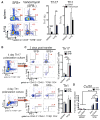Segmented Filamentous Bacteria Provoke Lung Autoimmunity by Inducing Gut-Lung Axis Th17 Cells Expressing Dual TCRs
- PMID: 29120746
- PMCID: PMC5749641
- DOI: 10.1016/j.chom.2017.10.007
Segmented Filamentous Bacteria Provoke Lung Autoimmunity by Inducing Gut-Lung Axis Th17 Cells Expressing Dual TCRs
Abstract
Lung complications are a major cause of rheumatoid arthritis-related mortality. Involvement of gut microbiota in lung diseases by the gut-lung axis has been widely observed, but the underlying mechanism remains mostly unknown. Using an autoimmune arthritis model, we show that a constituent of the gut microbiota, segmented filamentous bacteria (SFB), distantly provoke lung pathology. SFB induce autoantibodies in lung during the pre-arthritic phase, and SFB-dependent lung pathology requires the T helper 17 (Th17) responses. SFB-induced gut Th17 cells are preferentially recruited to lung over spleen due to robust expression in the lung of the Th17 chemoattractant, CCL20. Additionally, we found that in peripheral tissues, SFB selectively expand dual T cell receptor (TCR)-expressing Th17 cells recognizing both an SFB epitope and self-antigen, thus augmenting autoimmunity. This study reveals mechanisms for commensal-mediated gut-lung crosstalk and dual TCR-based autoimmunity.
Keywords: Th17 cells; autoimmune; dual TCR; gut microbiota; gut-lung axis; rheumatoid arthritis.
Copyright © 2017 Elsevier Inc. All rights reserved.
Figures




Similar articles
-
Gut Commensal Segmented Filamentous Bacteria Fine-Tune T Follicular Regulatory Cells to Modify the Severity of Systemic Autoimmune Arthritis.J Immunol. 2021 Mar 1;206(5):941-952. doi: 10.4049/jimmunol.2000663. Epub 2021 Jan 18. J Immunol. 2021. PMID: 33462137 Free PMC article.
-
The impact of age and gut microbiota on Th17 and Tfh cells in K/BxN autoimmune arthritis.Arthritis Res Ther. 2017 Aug 15;19(1):188. doi: 10.1186/s13075-017-1398-6. Arthritis Res Ther. 2017. PMID: 28810929 Free PMC article.
-
Synthetic Retinoid AM80 Ameliorates Lung and Arthritic Autoimmune Responses by Inhibiting T Follicular Helper and Th17 Cell Responses.J Immunol. 2017 Mar 1;198(5):1855-1864. doi: 10.4049/jimmunol.1601776. Epub 2017 Jan 27. J Immunol. 2017. PMID: 28130500 Free PMC article.
-
Toll-like receptor mediated modulation of T cell response by commensal intestinal microbiota as a trigger for autoimmune arthritis.J Immunol Res. 2015;2015:527696. doi: 10.1155/2015/527696. Epub 2015 Feb 23. J Immunol Res. 2015. PMID: 25802876 Free PMC article. Review.
-
How the Interplay Between the Commensal Microbiota, Gut Barrier Integrity, and Mucosal Immunity Regulates Brain Autoimmunity.Front Immunol. 2019 Aug 16;10:1937. doi: 10.3389/fimmu.2019.01937. eCollection 2019. Front Immunol. 2019. PMID: 31475000 Free PMC article. Review.
Cited by
-
Next-Generation Probiotics and Their Metabolites in COVID-19.Microorganisms. 2021 Apr 27;9(5):941. doi: 10.3390/microorganisms9050941. Microorganisms. 2021. PMID: 33925715 Free PMC article. Review.
-
Consideration of Gut Microbiome in Murine Models of Diseases.Microorganisms. 2021 May 14;9(5):1062. doi: 10.3390/microorganisms9051062. Microorganisms. 2021. PMID: 34068994 Free PMC article. Review.
-
Gut microecological regulation on bronchiolitis and asthma in children: A review.Clin Respir J. 2023 Oct;17(10):975-985. doi: 10.1111/crj.13622. Epub 2023 Apr 27. Clin Respir J. 2023. PMID: 37105551 Free PMC article. Review.
-
Mild heat stress changes the microbiota diversity in the respiratory tract and the cecum of layer-type pullets.Poult Sci. 2020 Dec;99(12):7015-7026. doi: 10.1016/j.psj.2020.09.024. Epub 2020 Sep 18. Poult Sci. 2020. PMID: 33248618 Free PMC article.
-
Response to Fungal Dysbiosis by Gut-Resident CX3CR1+ Mononuclear Phagocytes Aggravates Allergic Airway Disease.Cell Host Microbe. 2018 Dec 12;24(6):847-856.e4. doi: 10.1016/j.chom.2018.11.003. Epub 2018 Nov 29. Cell Host Microbe. 2018. PMID: 30503509 Free PMC article.
References
-
- Alam SM, Gascoigne NR. Posttranslational regulation of TCR Valpha allelic exclusion during T cell differentiation. J Immunol. 1998;160:3883–3890. - PubMed
-
- Albert LJ, Inman RD. Molecular mimicry and autoimmunity. N Engl J Med. 1999;341:2068–2074. - PubMed
-
- Budden KF, Gellatly SL, Wood DL, Cooper MA, Morrison M, Hugenholtz P, Hansbro PM. Emerging pathogenic links between microbiota and the gut-lung axis. Nat Rev Microbiol. 2017;15:55–63. - PubMed
Publication types
MeSH terms
Substances
Grants and funding
LinkOut - more resources
Full Text Sources
Other Literature Sources
Medical
Molecular Biology Databases

